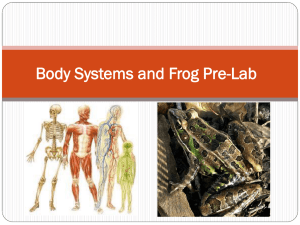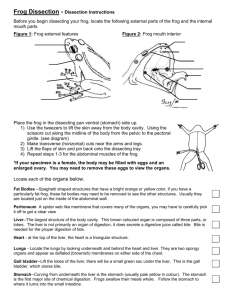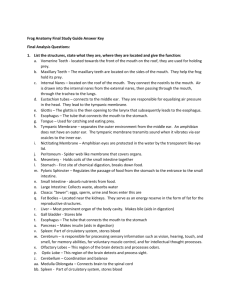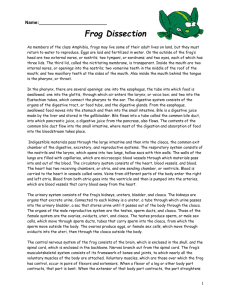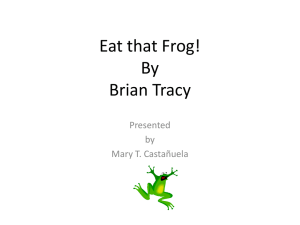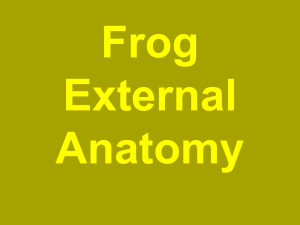Frog dissection 2014
advertisement
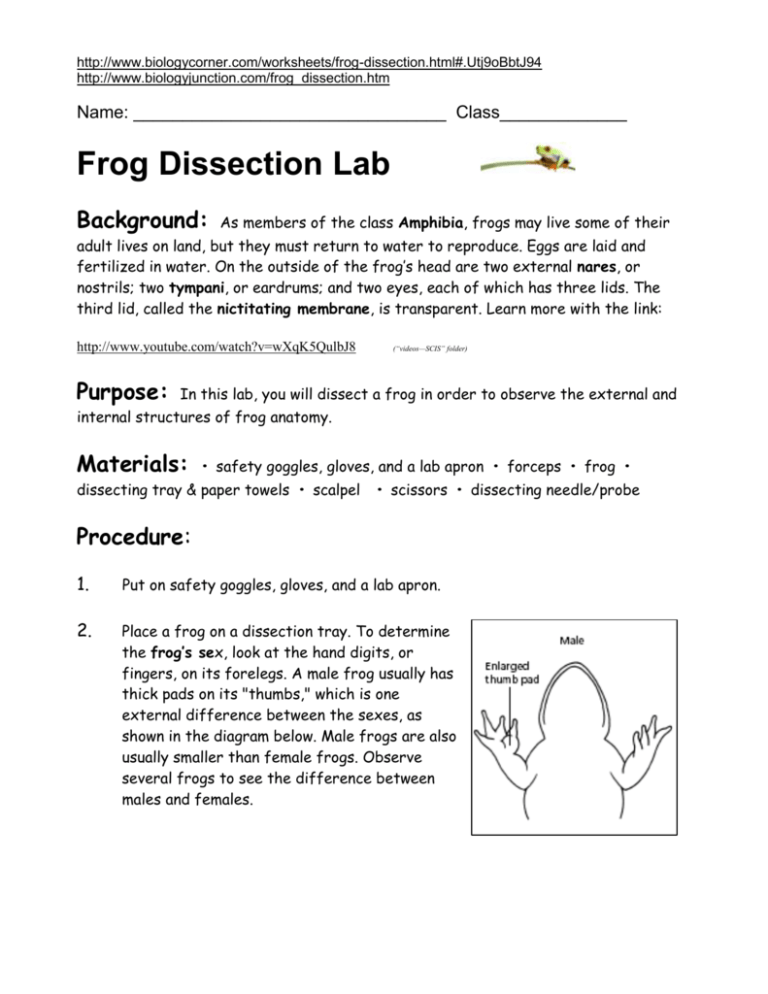
http://www.biologycorner.com/worksheets/frog-dissection.html#.Utj9oBbtJ94 http://www.biologyjunction.com/frog_dissection.htm Name: ________________________________ Class_____________ Frog Dissection Lab Background: As members of the class Amphibia, frogs may live some of their adult lives on land, but they must return to water to reproduce. Eggs are laid and fertilized in water. On the outside of the frog’s head are two external nares, or nostrils; two tympani, or eardrums; and two eyes, each of which has three lids. The third lid, called the nictitating membrane, is transparent. Learn more with the link: http://www.youtube.com/watch?v=wXqK5QulbJ8 (“videos—SCIS” folder) Purpose: In this lab, you will dissect a frog in order to observe the external and internal structures of frog anatomy. Materials: • safety goggles, gloves, and a lab apron • forceps • frog • dissecting tray & paper towels • scalpel • scissors • dissecting needle/probe Procedure: 1. Put on safety goggles, gloves, and a lab apron. 2. Place a frog on a dissection tray. To determine the frog’s sex, look at the hand digits, or fingers, on its forelegs. A male frog usually has thick pads on its "thumbs," which is one external difference between the sexes, as shown in the diagram below. Male frogs are also usually smaller than female frogs. Observe several frogs to see the difference between males and females. 3. Use the diagram below to locate and identify the external features of the head. Find the mouth, external nares, tympani, eyes, and nictitating membranes. 4. Turn the frog on its back. Cut the hinges of the mouth and open it wide. Use the diagram below to locate and identify the structures inside the mouth. Use a probe to help find each part: the vomerine teeth, the maxillary teeth, the internal nares, the tongue, the openings to the Eustachian tubes, the esophagus, the pharynx, and the slit-like glottis. 5. Look for the opening to the frog’s cloaca, located between the hind legs. Use forceps to lift the skin and use scissors to cut along the center of the body from the cloaca to the lip. Turn back the skin, cut toward the side at each leg. The diagram above shows how to make these cuts 6. Lift and cut through the muscles and breast bone (sternum) to open up the body cavity. If your frog is a female, the abdominal cavity may be filled with darkcolored eggs. If so, move the eggs to one side so you can see the organs underlying them. 7. Use the diagram below to locate and identify the organs of the digestive system: esophagus, stomach, small intestine, large intestine, cloaca, spleen, liver, gallbladder, and pancreas. 8. Refer to the diagram below to identify the parts of the circulatory and respiratory systems that are in the chest cavity. Find the left atrium, right atrium, and ventricle of the heart. Find an artery attached to the heart and another artery near the backbone. Find a vein near one of the shoulders. Find the two lungs. 9. Use a probe and scissors to lift and remove the intestines and liver. Use the diagram below to identify parts of the urinary and reproductive systems. Remove the peritoneal membrane, which is connective tissue on top of the red kidneys. Observe the yellow fat bodies that are attached to the kidneys. Find the ureters; the urinary bladder; the testes and sperm ducts in the male; and the ovaries, oviducts, and uteri in the female. 10. Dissect a thigh. Note the size and texture of the leg muscles. 11. Throw the dissected frog and all of its body parts into the trash. Clean the dissecting equipment with soap and water, including the dissecting tray. Be sure to dry everything completely. Wipe down your table top with a wet paper towel and wash your hands with soap and water before you leave the room. Clean up your work area and wash your hands before leaving the lab. DISSECTION CHECK LIST! Check off each thing when you find it during your dissection. Be sure to get the measurements at the end of this list!! 1. Fat Bodies --Spaghetti shaped structures that have a bright orange or yellow color, if you have a particularly fat frog, these fat bodies may need to be removed to see the other structures. Usually they are located just on the inside of the abdominal wall. 2. Peritoneum - A spider web like membrane that covers many of the organs, you may have to carefully pick it off to get a clear view 3. Liver--The largest structure of the body cavity. This brown colored organ is composed of three parts, or lobes. The right lobe, the left anterior lobe, and the left posterior lobe. The liver is not primarily an organ of digestion, but it does secrete a digestive juice called bile. Bile is needed for the proper digestion of fats. 4. Heart - at the top of the liver, the heart is a triangular structure. The left and right atrium can be found at the top of the heart. A single ventricle located at the bottom of the heart. The large vessel extending out from the heart is the conus arteriosis (Aorta in humans). 5. Lungs - Locate the lungs by looking underneath and behind the heart and liver. They are two spongy organs. 6. Gall Bladder --Lift the lobes of the liver, there will be a small green sac under the liver. This is the gall bladder, which stores bile. (hint: it kind of looks like a booger) 7. Stomach--Curving from underneath the liver is the stomach. The stomach is the first major site of chemical digestion. Frogs swallow their meals whole. Follow the stomach to where it turns into the small intestine. 8. Small Intestine--Leading from the stomach. The small intestine is held together by a membrane called the mesentery. Note the blood vessels running through the mesentery, they will carry absorbed nutrients away from the intestine. Absorption of digested nutrients occurs in the small intestine. 9. Large Intestine--As you follow the small intestine down, it will widen into the large intestine. The large intestine is also known as the cloaca in the frog. The cloaca is the last stop before wastes, sperm, or urine exit the frog's body. (The word "cloaca" means sewer) 10. Spleen--Return to the folds of the mesentery, this dark red spherical object serves as a holding area for blood. 11. Esophagus--Return to the stomach and follow it upward, where it gets smaller is the beginning of the esophagus. The esophagus is the tube that leads from the frog’s mouth to the stomach. Open the frog’s mouth and find the esophagus, poke your probe into it and see where it leads. STOP! Do not continue If you have not located each of the organs above. Removal of the Stomach: Cut the stomach out of the frog and open it up. You may find what remains of the frog's last meal in there. Look at the texture of the stomach on the inside. What did you find in the stomach? Measuring the Small intestine: Remove the small intestine from the body cavity and carefully separate the mesentery from it. Stretch the small intestine out and measure it. Now measure your frog. Record the measurements below in centimeters. Frog length: _______ cm Intestine length ________ cm Post Lab Questions: Complete these questions (and labeling) and turn in next class. 1. The membrane that holds coils of the small intestine together: ___________ 2.This organ is found under the liver, it stores bile: ______________________ 3. Name the 3 lobes of the liver: ________________, ___________________, ____________________ 4. The organ that is the first major site of chemical digestion: ____________ 5. Eggs, sperm, urine and wastes all empty into this structure: ___________ 6. The small intestine leads from the: __________________________ 7. The esophagus leads to the: _________________________ 8. Dark red spherical object that holds blood: ____________________ 9. The first part of the small intestine (straight part): ____________________ 10. After food passes through the stomach it enters the: __________________ 11. A spider-web like membrane that covers the organs: __________________ 12. Regulates the exit of partially digested food from the stomach: __________ 13. The large intestine leads to the __________________ . Label the Diagram A. ______________________ B. ______________________ C. ______________________ D. ______________________ E. ______________________ F. ______________________ G. ______________________ H. ______________________ I. ______________________ J. ______________________ K. ______________________ L. ______________________ M. ______________________ N. ______________________ Compare your frog’s skeleton to the diagram on the right. Makes a great tattoo!
